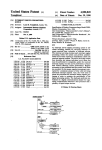Download Locks: Hardware Support
Transcript
20
Locks: Hardware Support
To go beyond Peterson’s algorithm and to build a working lock,
we will need some help from our old friend, the hardware. Over
the years, a number of different hardware primitives have been
added to the instruction sets of various computer architectures;
while we won’t study how these instructions are implemented
(that, after all, is the topic of a computer architecture class), we
will study how to use them in order to build a mutual exclusion
primitive like a lock.
As we saw in previous notes, while it is possible to build
crude locks with just loads and stores, modern systems need
more in order to correctly build locks. And thus we arrive at the
crux of the problem:
T HE C RUX : H ARDWARE L OCK S UPPORT
What hardware support is needed to build locks and provide mutual exclusion for critical sections? Given new hardware
primitives, how can we use them to build locks that are efficient
and meet our requirements?
1
2
L OCKS : H ARDWARE S UPPORT
20.1
Test-And-Set
Some systems provide a form of what is called test-and-set in
a single atomically-executed instruction (one example is SPARC,
which has a ldstub instruction [WG00]). You can think of this
instruction as doing what this function does:
int TestAndSet(int *lock, int new) {
int old = *lock;
*lock = new;
return old;
}
What the code does is as follows. It returns the old value
pointed to by the lock, and simultaneously updates said value
to new. The key, of course, is that this sequence of operations is
performed atomically 1 . We can use such a primitive to build a
simple lock that works, as in Figure 20.1.
typedef struct __lock_t {
int flag;
}
void init(lock_t *lock) {
// 0 indicates that lock is available, 1 that it is held by a thread
lock->flag = 0;
}
void lock(lock_t *lock) {
while (TestAndSet(&lock->flag, 1) == 1)
; // spin-wait (do nothing)
}
void unlock(lock_t *lock) {
lock->flag = 0;
}
Figure 20.1: A Simple Lock using Test-and-set
1
How does the hardware do this? Well, you’ll have to take a hardware class
to learn that. Sorry!
O PERATING
S YSTEMS
A RPACI -D USSEAU
L OCKS : H ARDWARE S UPPORT
3
Let’s make sure we understand why this works. Imagine first
the case where a thread calls lock() and no other thread currently
holds the lock; thus, flag should be 0. When the thread then calls
TestAndSet(flag, 1), the routine will return the old value
of the flag, which is 0; thus, the calling thread, which is testing
the value of flag, will not get caught spinning in the while loop
and will acquire the lock. The thread will also atomically set the
value to 1, thus indicating that the lock is now held. When the
thread is finished with its critical section, it simple calls unlock
to set the flag back to zero.
The second case we can imagine arises when one thread already has the lock held (i.e., flag = 1). In this case, this thread
will call lock() and then call TestAndSet(flag, 1) as well.
This time, however, TestAndSet() will return the old value at
flag, which is 1 (because the lock is held), while simultaneously
setting it to 1 again. While the lock is held by another thread,
TestAndSet() will repeatedly return 1, and thus this thread
will spin and spin until the lock is finally released. When the
flag is finally set to 0 by some other thread, this thread will call
TestAndSet() again, which will finally return 0 while atomically setting the value to 1 and thus acquire the lock.
Thus, by making both the test (of the old value of the lock)
and set (of new value) one atomic operation, we can ensure that
only one thread acquires the lock, and thus we can build a successful mutual exclusion primitive.
20.2
Compare-And-Swap
Another hardware primitive that some systems provide is
known as the compare-and-swap instruction (as it is called on
SPARC, for example), or compare-and-exchange (as it called on
x86). The C pseudocode for this single instruction is found in
Figure 20.2.
The basic idea is for compare-and-swap to test whether the
value at the address specified by ptr is equal to expected;
if so, update the memory location pointed to by ptr with the
A RPACI -D USSEAU
W HAT
H APPENS
W HEN
4
L OCKS : H ARDWARE S UPPORT
int CompareAndSwap(int *ptr, int expected, int new) {
int actual = *ptr;
if (actual == expected)
*ptr = new;
return actual;
}
Figure 20.2: Compare-and-swap
new value. If not, do nothing. In either case, return the actual
value at that memory location, thus allowing the code calling
compare-and-swap to know whether it succeeded or not.
With the compare-and-swap instruction, we can build a lock
in a manner quite similar to that with test-and-set. For example, we could just replace the lock() routine above with the
following:
void lock(lock_t *lock) {
while (CompareAndSwap(&lock->flag, 0, 1) == 1)
; // spin
}
The rest of the code is the same as the test-and-set example
above. This code works quite similarly; it simply checks if the
flag is 0 and if so, atomically swaps in a 1 thus acquiring the
lock. Threads that try to acquire the lock while it is held will get
stuck spinning until the lock is finally released.
If you want to see how to really make a C-callable x86-version
of compare-and-swap, this code sequence might be useful (stolen
from here [S05]):
char CompareAndSwap(int *ptr, int old, int new) {
unsigned char ret;
// Note that sete sets a ’byte’ not the word
__asm__ __volatile__ (
" lock\n"
" cmpxchgl %2,%1\n"
" sete %0\n"
: "=q" (ret), "=m" (*ptr)
: "r" (new), "m" (*ptr), "a" (old)
: "memory");
return ret;
}
O PERATING
S YSTEMS
A RPACI -D USSEAU
L OCKS : H ARDWARE S UPPORT
5
Finally, as you may have sensed, compare-and-swap is a more
powerful instruction than test-and-set. We will make good use
of this power in the future when we briefly delve into wait-free
synchronization.
20.3
Load-Linked and Store-Conditional
Some platforms provide a pair of instructions that work in
concert to help build critical sections. On the MIPS architecture [H93], for example, the load-linked and store-conditional
instructions can be used in tandem to build locks and other concurrent structures. The C pseudocode for these instructions is
as found in Figure 20.3. Alpha, PowerPC, and later versions of
ARM provide similar instructions [W09].
int LoadLinked(int *ptr) {
return *ptr;
}
int StoreConditional(int *ptr, int value) {
if (no one has updated *ptr since the load_linked to this address) {
*ptr = value;
return 1; // success!
} else {
return 0; // failed to update
}
}
Figure 20.3: Load-linked and Store-conditional
The load-linked operates much like a typical load instruction, and simply fetches a value from memory and places it in
a register. The key difference comes with the store-conditional,
which only succeeds (and updates the value stored at the address just load-linked from) if no intermittent store to the address has taken place. In the case of success, the store-conditional
returns 1 and updates the value at ptr to value; if it fails, the
value pointed to by ptr is not updated and 0 is returned.
As a challenge to yourself, try thinking about how to build a
lock using load-linked and store-conditional. Then, when you
are finished, look at the code below which provides one simple
solution. Do it! The solution is in Figure 20.4.
A RPACI -D USSEAU
W HAT
H APPENS
W HEN
6
L OCKS : H ARDWARE S UPPORT
void lock(lock_t *lock) {
while (1) {
while (LoadLinked(&lock->flag) == 1)
; // spin until it’s zero
if (StoreConditional(&lock->flag, 1) == 1)
return; // if set-it-to-1 was a success: all done
// otherwise try it again
}
}
void unlock(lock_t *lock) {
lock->flag = 0;
}
Figure 20.4: Using LL/SC To Build A Lock
The lock() code is the only interesting piece. First, a thread
spins waiting for the flag to be set to 0 (and thus indicate the
lock is not held). Once so, the thread tries to acquire the lock via
the store-conditional; if it succeeds, the thread has atomically
changed the value of the flag to 1 and thus can proceed into the
critical section.
Note how failure of the store-conditional might arise. One
thread calls lock() and executes the load-linked, returning 0 as
the lock is not held. Before it can attempt the store-conditional,
it is interrupted and another thread enters the lock code, also
executing the load-linked instruction, and also getting a 0 and
continuing. At this point, two threads have each executed the
load-linked and each are about to attempt the store-conditional.
The key feature of these instructions is that only one of these
threads will succeed in updating the flag to 1 and thus acquire
the lock; the second thread to attempt the store-conditional will
fail (because the other thread updated the value of flag between
its load-linked and store-conditional) and thus have to try to
acquire the lock again.
In class, David Capel2 suggested a more concise form of the
above, for those of you who enjoy short-circuiting boolean con2
O PERATING
S YSTEMS
Now famous.
A RPACI -D USSEAU
L OCKS : H ARDWARE S UPPORT
7
ditionals. See if you can figure out why it is equivalent:
void lock(lock_t *lock) {
while (LoadLinked(&lock->flag) || StoreConditional(&lock->flag, 1))
; // spin
}
20.4
Fetch-And-Add
One final hardware primitive is the fetch-and-add instruction. In assembly, it might look like this:
fetch-and-add <address>, rold
Its behavior is very simple: it atomically increments whatever the value is pointed to by the address, and puts the old
value (before the increment) into register rold. The C pseudocode looks like this:
int FetchAndAdd(int *ptr) {
int old = *ptr;
*ptr = old + 1;
return old;
}
In this example, we’ll use fetch-and-add to build a more interesting ticket lock, as introduced by Mellor-Crummey and
Scott [MS91]. The lock and unlock code looks something like
what you see in Figure 20.5.
Instead of a single value, this solution uses a ticket and turn
variable in combination to build a lock. The basic operation is
pretty simple: when a thread wishes to acquire a lock, it first
does an atomic fetch-and-add on the ticket value; that value
is now considered this thread’s “turn” (myturn). The globally
shared lock->turn is then used to determine which thread’s
turn it is; when (myturn == turn) for a given thread, it is
that thread’s turn to enter the critical section. Unlock is accomplished simply by incrementing the turn such that the next waiting thread (if there is one) can now enter the critical section.
A RPACI -D USSEAU
W HAT
H APPENS
W HEN
8
L OCKS : H ARDWARE S UPPORT
typedef struct __lock_t {
int ticket;
int turn;
} lock_t;
void lock_init(lock_t *lock) {
lock->ticket = 0;
lock->turn
= 0;
}
void lock(lock_t *lock) {
int myturn = fetchandadd(&lock->ticket);
while (lock->turn != myturn)
; // spin
}
void unlock(lock_t *lock) {
fetchandadd(&lock->turn);
}
Figure 20.5: Ticket Locks
Note one important difference with this solution versus our
previous attempts: it ensures progress for all threads. Once a
thread is assigned its ticket value, it will be scheduled at some
point in the future (once those in front of it have passed through
the critical section and released the lock). In our previous attempts, no such guarantee existed; a thread spinning on testand-set (for example) could spin forever even as other threads
acquire and release the lock.
20.5
Summary: So Much Spinning
Our simple hardware-based locks are simple (only a few lines
of code) and they work (you could even prove that if you’d
like to), which are two excellent properties of any system or
code. However, in some cases, these solutions can be quite inefficient. Imagine you are running two threads on a single processor. Now imagine that one thread (thread 0) is in a critical
O PERATING
S YSTEMS
A RPACI -D USSEAU
L OCKS : H ARDWARE S UPPORT
9
section and thus has a lock held, and unfortunately gets interrupted. The second thread (thread 1) now tries to acquire the
lock, but finds that it is held. Thus, it begins to spin. And spin.
Then it spins some more. And finally, a timer interrupt goes
off, thread 0 is run again, which releases the lock, and finally
(the next time it runs, say), thread 1 won’t have to spin so much
and will be able to acquire the lock. Thus, any time a thread
gets caught spinning in a situation like this, it wastes an entire
time slice doing nothing but checking a value that isn’t going
to change! The problem gets worse with N threads contending
for a lock; N − 1 time slices may be wasted in a similar manner,
simply spinning and waiting for a single thread to release the
lock. And thus, our next problem:
T HE C RUX : T OO M UCH S PINNING
How can we develop a lock that doesn’t needlessly waste
time spinning on the CPU?
Hardware support alone cannot solve the problem. We’ll
need OS support too, which is the topic of the next note.
A RPACI -D USSEAU
W HAT
H APPENS
W HEN
10
L OCKS : H ARDWARE S UPPORT
References
[H93] “MIPS R4000 Microprocessor User’s Manual”.
Joe Heinrich, Prentice-Hall, June 1993
Available: http://cag.csail.mit.edu/raw/
documents/R4400 Uman book Ed2.pdf
[MS91] “Algorithms for Scalable Synchronization on Shared-Memory Multiprocessors”
John M. Mellor-Crummey and M. L. Scott
ACM TOCS, February 1991
[S05] “Guide to porting from Solaris to Linux on x86”
Ajay Sood, April 29, 2005
Available: http://www.ibm.com/developerworks/linux/library/l-solar/
[W09] “Load-Link, Store-Conditional”
Wikipedia entry on said topic, as of October 22, 2009
http://en.wikipedia.org/wiki/Load-Link/Store-Conditional
Can you believe I referenced wikipedia? Pretty shabby. But, I found the information
there first, and it felt funny not to cite it. Further, they even listed the instructions for
the different architectures: ldl l/stl c and ldq l/stq c (Alpha), lwarx/stwcx
(PowerPC), ll/sc (MIPS), and ldrex/strex (ARM version 6 and above).
[WG00] “The SPARC Architecture Manual: Version 9”
David L. Weaver and Tom Germond, September 2000
SPARC International, San Jose, California
Available: http://www.sparc.org/standards/SPARCV9.pdf
Also see: http://developers.sun.com/solaris/articles/atomic sparc/
for some more details on Sparc atomic operations.
O PERATING
S YSTEMS
A RPACI -D USSEAU

























